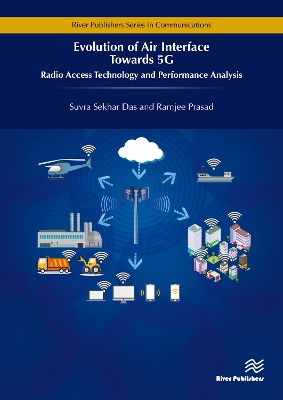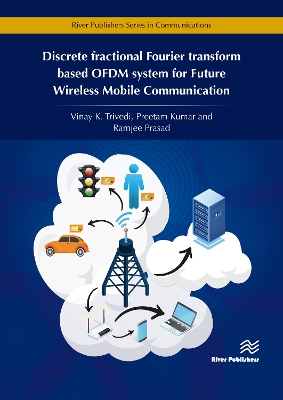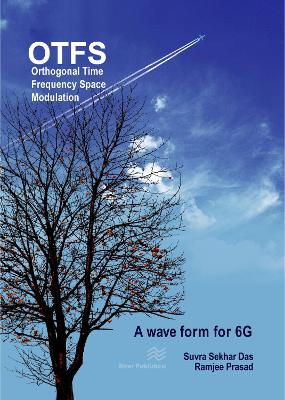River Publishers Communications
3 total works
Over the past few decades, wireless access networks have evolved extensively to support the tremendous growth of consumer traffic. This superlative growth of data consumption has come about due to several reasons, such as evolution of the consumer devices, the types of telephone and smartphone being used, convergence of services, digitisation of economic transactions, tele-education, telemedicine, m-commerce, virtual reality office, social media, e-governance, e-security, to name but a few.
Not only has the society transformed to a digital world, but also the expectations from the services provided have increased many folds. The last mile/meters of delivery of all e-services is now required to be wireless. It has always been known that wireless links are the bottleneck to providing high data rates and high quality of service. Several wireless signalling and performance analysis techniques to overcome the hurdles of wireless channels have been developed over the last decade, and these are fuelling the evolution of 4G towards 5G. Evolution of Air Interface Towards 5G attempts to bring out some of the important developments that are contributing towards such growth.
Not only has the society transformed to a digital world, but also the expectations from the services provided have increased many folds. The last mile/meters of delivery of all e-services is now required to be wireless. It has always been known that wireless links are the bottleneck to providing high data rates and high quality of service. Several wireless signalling and performance analysis techniques to overcome the hurdles of wireless channels have been developed over the last decade, and these are fuelling the evolution of 4G towards 5G. Evolution of Air Interface Towards 5G attempts to bring out some of the important developments that are contributing towards such growth.
Discrete fractional Fourier transform based OFDM system for Future Wireless Mobile Communication
by Vinay K Trivedi, Preetam Kumar, and Ramjee Prasad
Published 30 April 2022
Orthogonal frequency division multiplexing (OFDM) is an attractive physical layer waveform candidate for wireless broadband communication. Apart from being spectrally efficient with overlapping subcarriers, the OFDM system enables simplified equalization at the receiver and effectively combats the inter-block interference with cyclic prefix. For achieving low peak-to-average power ratio (PAPR) in the uplink, single carrier frequency domain multiple access (SC-FDMA) is used for fourth-generation (4G), long term evolution (LTE). SC-FDMA achieves low PAPR compared to OFDMA using discrete Fourier transform (DFT) precoding. This book introduces both OFDM and SC-FDMA, similarities, and differences between their transmitter and receiver operations, time-frequency representations, and low complexity joint equalization and CFO compensation (JECC), etc. Advanced waveform candidates such as Filtered OFDM, FBMC, GFDM, etc. are also introduced. To improve the throughput of existing mobile communication, non-orthogonal multiple access (NOMA) system configurations based on OFDM are also covered.
Essentially, the performance of both the OFDMA and SC-FDMA is very sensitive to the presence of carrier frequency offset (CFO) arising from synchronization errors, Doppler, and manufacturing defects. This is because the multicarrier structure and the channel decomposition at the receiver based on DFT lose its optimal performance in the presence of CFO. This book discusses an elegant time-frequency signal processing tool for this purpose called fractional Fourier transform (FRFT). A discrete version of FRFT (or DFRFT) employing a chirp basis in place of the complex exponential basis of DFT can easily replace the existing multicarrier modulation/demodulation and channel decomposition. A detailed performance evaluation of the DFRFT based OFDM system that can significantly outperform the conventional DFT based OFDM system is also given. The study presented involves a detailed interference analysis of the DFRFT based OFDM system in the presence of CFO. This inter carrier interference (ICI) analysis is then used to devise Low complexity JECC for DFRFT based OFDM. Through the study and result presented in this book, the use of the DFRFT based OFDM system is motivated for wireless mobile communication especially in the presence of CFO.
Essentially, the performance of both the OFDMA and SC-FDMA is very sensitive to the presence of carrier frequency offset (CFO) arising from synchronization errors, Doppler, and manufacturing defects. This is because the multicarrier structure and the channel decomposition at the receiver based on DFT lose its optimal performance in the presence of CFO. This book discusses an elegant time-frequency signal processing tool for this purpose called fractional Fourier transform (FRFT). A discrete version of FRFT (or DFRFT) employing a chirp basis in place of the complex exponential basis of DFT can easily replace the existing multicarrier modulation/demodulation and channel decomposition. A detailed performance evaluation of the DFRFT based OFDM system that can significantly outperform the conventional DFT based OFDM system is also given. The study presented involves a detailed interference analysis of the DFRFT based OFDM system in the presence of CFO. This inter carrier interference (ICI) analysis is then used to devise Low complexity JECC for DFRFT based OFDM. Through the study and result presented in this book, the use of the DFRFT based OFDM system is motivated for wireless mobile communication especially in the presence of CFO.
Orthogonal Time Frequency Space Modulation
by Suvra Sekhar Das and Ramjee Prasad
Published 29 December 2021


